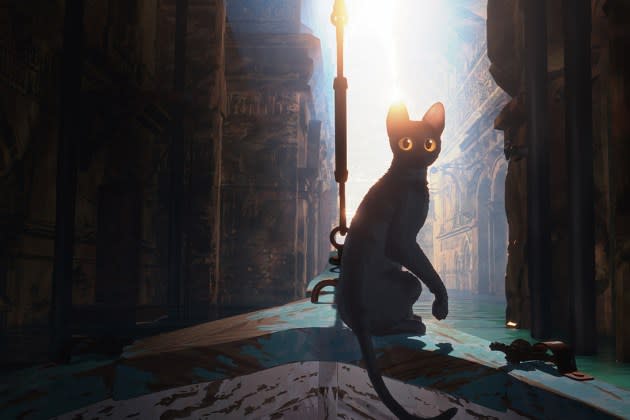‘Flow’ Review: An Enchanting Eco-Fable About Community That Makes Artisanal Magic Out of 3D Animation

At the risk of sounding hyperbolic, there’s something about the purity of great animated storytelling that can shatter your heart and then make it whole again. (Think Toy Story 3.) Latvian director Gints Zilbalodis’ captivating second feature, Flow, is that kind of marvel, a vividly experiential white-knuckle survival adventure that takes place in a world on the brink of ruin. Told entirely without dialogue, this tale of a cat that evolves from self-preservation to solidarity with a motley crew of other species is something quite special.
Acquired out of Cannes for North America by Sideshow and Janus Films, Flow is of a piece with Zilbalodis’ lauded 2019 debut Away; both are essentially silent movies and both owe a debt to the painterly canvases of animation master Hayao Miyazaki. The new work drops characters designed in classic cartoon style into ravishing photo-realistic environments, at times recalling the woodsy landscapes of Danish artist Peder M?rk M?nsted. Images of nature shimmer with light and color, though a shadow of danger is never far away.
More from The Hollywood Reporter
The cat at the center of the story is a skinny gray feline of indeterminate gender that looks to be somewhere between kittenhood and full maturity. It’s clever and resilient but also skittish, a small creature in a big scary forest, bizarrely dotted with large-scale cat sculptures, including one giant kitty that towers above the treetops. Scaffolding indicates that it’s a work left unfinished, one of many signs throughout the film that human life has perished.
After outwitting five dogs in hot pursuit during a suspenseful chase, the cat discovers the origin of those artworks in an isolated cottage with a wood carver’s workshop. The animal enters through a broken window and promptly curls up on a bed to sleep.
The cat later ventures back out into the woods and narrowly escapes being trampled by a deer stampede. That’s followed, seconds later, by a torrential flood that sweeps through the forest with devastating force. As the waters continue to rise, the cat keeps scrambling onto higher ground, eventually scaling the sculpture that dominates the skyline, climbing to the top of the head and then up onto the point of one ear.
What follows is an eventful journey, propulsively paced and yet never rushed even at a brisk 86 minutes, giving breathing room both to nail-biting interludes and more touching moments. The cat hops onto a beaten up sailboat and travels up a swollen river, gradually adapting to the challenges of this new waterworld.
The animal’s expressive saucer eyes widen with each new encounter — a capybara that barks once and then plops itself down to sleep, posing no threat; an acquisitive lemur busily collecting an array of shiny objects in a basket it guards irritably; a sweet, not too bright labrador separated from the hound pack; and a secretary bird that initially seems a menace but soon settles on the prow of the boat, mostly minding its own business.
As woodlands make way for more tropical vegetation, the animals pass ruins of what appears to be a grand ancient city with a massive amphitheater that’s home to a colony of lemurs, each of them sporting its own found treasures as accessories.
All the animals on the boat are changed by their experiences, with the exception of the capybara, who remains pretty much the same big easygoing lug throughout. Even the labrador, shrugging off the pack mentality of the other dogs, becomes smarter, more alert to the safety of its fellow travelers.
None changes more perceptibly than the cat, its brushes with death likely outnumbering the standard nine lives and its cohabitation with the other species fostering a communal spirit unlike its more aloof, circumspect behavior earlier in the story.
This is a wonderful film for children, its example of the give and take of friendship and the importance of mutual trust embedded organically in the narrative with clarity but without over-emphasis. It’s no less a film for adults, with its beguiling visuals and characters loaded with charm and individuality. There’s a lovely understated spiritual element, a soulfulness that resonates profoundly with the fate of a gigantic sea creature, or the celestial exit of a member of the boat party.
Zilbalodis and director of animation Léo Silly-Pélissier conjure a picture-book world all but wiped out by natural disaster and shadowed by the specter of death but still abounding in sights of breathtaking beauty. The 3D animation renders the forest backgrounds with incredibly vibrant textures and the underwater scenes are enchanting, even when you fear for the life of the cat, an aquatic newbie. The visual aesthetic is polished, but the film still somehow manages to seem both technically accomplished and hand-crafted.
The attention to movement is extraordinary, captured in graceful, controlled camerawork or careening along as the cat darts through the forest at high speed. The character detail is clearly the result of extensive study of each animal’s behavior and physicality; it seems especially safe to assume the creative team logged countless hours watching cat videos, inarguably the greatest gift of the online age.
The score by Zilbalodis and Rihards Zal shifts from gorgeous passages of percussive melody to flights of stirring strings, just as the narrative weaves humorous observations together with moments of high anxiety or tragedy. Flow is a joy to experience but also a deeply affecting story, the work of a unique talent who deserves to be ranked among the world’s great animation artists.
Best of The Hollywood Reporter